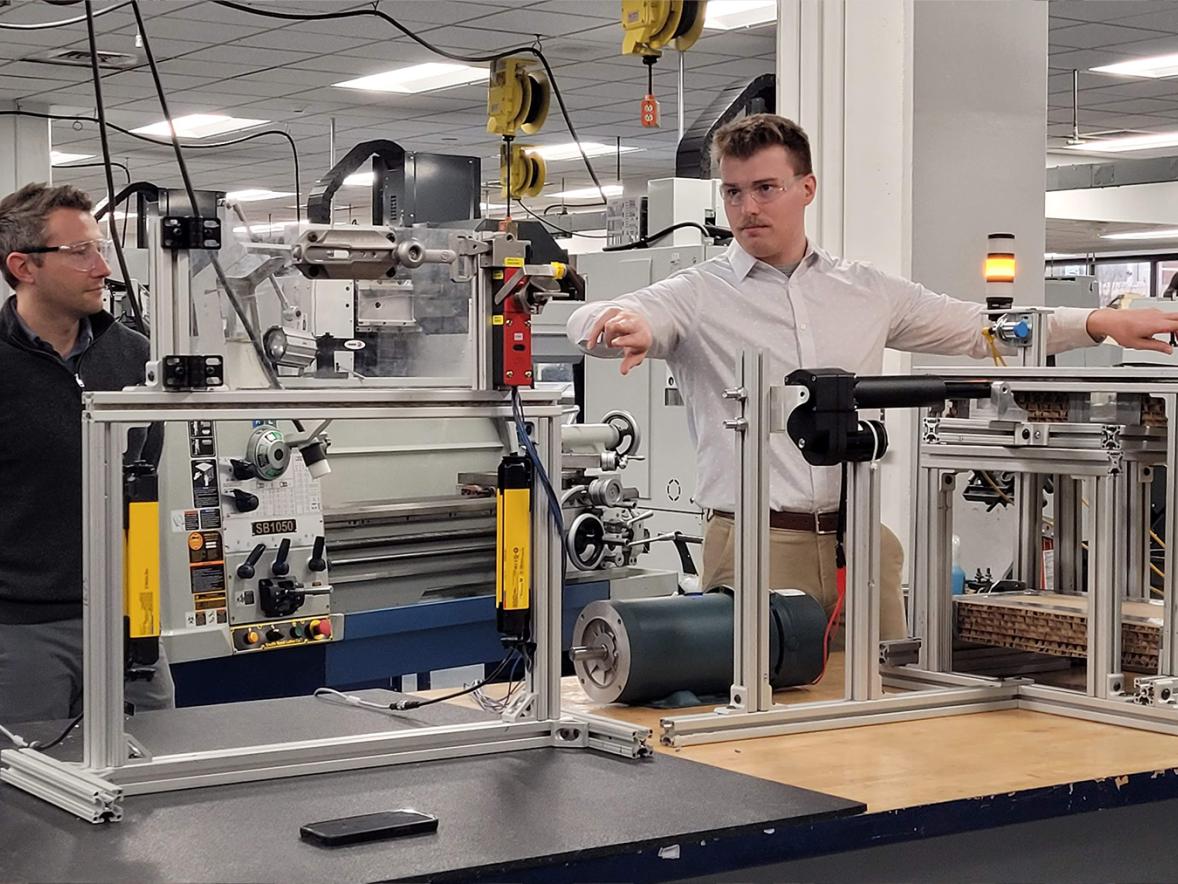This Q&A was published April 29, 2020, in the Eau Claire Leader-Telegram
By Ryan Patterson
Eau Claire Leader-Telegram
Businesses are facing many questions about how to respond to COVID-19. If they are considered essential and remain open, how should they balance employee safety with staying operational? If they are nonessential, should they reduce pay, furlough or lay off workers?
 To help sort through those thorny topics, Brian Finder, director of the UW-Stout risk control and safety management master’s program, recently emailed with the Leader-Telegram about how employers should think of the challenges posed by the coronavirus.
To help sort through those thorny topics, Brian Finder, director of the UW-Stout risk control and safety management master’s program, recently emailed with the Leader-Telegram about how employers should think of the challenges posed by the coronavirus.
Finder noted that his responses do not apply to all companies.
“The following interview reflects current knowledge and management practices regarding the methods to minimize the introduction and transmission of viral agents in the workplace,” Finder wrote. “Since different situations may result in varied types and levels of risk, readers are advised to consult with qualified legal advisement and/or representatives from Wisbar.org for further clarification on the methods to manage risks that are specific to their organization.”
This interview has been edited and condensed.
What is risk control and safety management?
Individuals who work in the risk control and safety management profession generally support the production or service sides of a business by providing timely and accurate advice on how to decrease the chance for employee injuries and illnesses as well as damage to the facility or the environment.
A fair number of our graduate program’s alumni also work for government agencies who partner with business and industrial entities to ensure that the employees work in areas that are reasonably free of recognized work hazards … These professionals are constantly monitoring the number of employees who have contracted COVID-19 and prompt needed changes to fever detection, employee distancing, worker scheduling and the facility disinfection-related activities that we’re generally witnessing in the workplace to prevent further COVID-19 viral infections.
Are current students looking at the response to COVID-19 for applied research?
Two of our full-time graduate students recently developed and presented current information regarding the COVID-19 virus in their industrial hygiene course … One of our students, who is currently working as a facility manager for a regionally based higher education institution, was recently tasked with developing a phase-1 reopening plan for laboratories that need to provide students with hands-on lab time. One of the concerns that her administrators expressed involved the need to limit the number of people in a room that is served by a single air handling system.
After some research, she found a recent American Society of Heating, Refrigeration and Air-Conditioning Engineers-sponsored article that provided guidance for building operations during the COVID-19 pandemic. Not only does this article offer reasonable recommendations on how to minimize the physical spread of the COVID-19 virus, but it also provides ideas on ways that the heating, ventilation and air conditioning (HVAC) systems can be operated to help minimize the spread of very small airborne virus droplets.
The constant discovery and application of such current information is helping working professionals who are being tasked to reopen facilities as soon as practical and yet ensure workforce and student protection.
What’s the largest risk posed by COVID-19?
One of the main activities that risk control and safety management professionals perform is to help their employers prioritize the organization’s moderate to high risks, especially those to the employee, and then work with the applicable areas to develop needed risk-reduction plans … At a minimum, it’s predictable that the current virus situation holds a high potential to cause forms of monetary loss because of workforce, time, material, product, energy and legal issues, as well as company reputation.
This is where the term “risk control” is used to emphasize a company’s need to manage all moderate-to-high risk situations. In our profession, we often use the term “total asset protection” in order to stress the organization’s need to protect all living and material items that have monetary value.
Are you consulting with area businesses or UW-Stout on how to respond to COVID-19? If so, what are the most common questions/concerns you’re hearing?
While I am currently not consulting because employers are trying to minimize the number of non-employees who enter the working environment, it’s interesting to learn of the varied questions that are posed to risk control and safety management professionals for companies that are still open.
Examples of questions that I’ve heard include “Should we perform employee forehead temperature monitoring during mid-shift times in addition to the beginning of the shift? Should we check the forehead temperatures of employees who leave and then return to the facility? Should we not allow employees to leave the facility during their lunch breaks? What are my options if another employee refuses to maintain the company’s current social distancing requirements?”
The answers to these and other questions are what risk control and safety management professionals need to research and recommend and then provide the necessary support to implement the desired controls in a cost-effective manner.
What should employers prioritize to keep employees safe?
It’s nearly a given that individuals who work in our profession realize the importance of understanding what the employees’ job duties entail. Within progressive organizations, teams of trained management and hourly employees perform formal risk assessments of certain worker tasks and/or equipment so that any higher-than-acceptable risks can be identified, analyzed and controlled.
Prior to this pandemic situation, it’s likely that a fair number of industrial risk assessments wouldn’t have examined the threat of a pathogen being transferred between two employees who are working side-by-side. Now we’re realizing that it’s necessary for any type of task and/or equipment-based risk assessment to also examine how close employee interface can result in pathogen transmission.
How can risk management professionals convey the gravity of the situation to their bosses? For example, what if a CEO didn’t initially take the health concerns seriously enough?
It’s likely that individuals who work in the risk control and safety management profession will likely speak a different risk-reduction language with the various audiences that they deal with in a given day. For example, in situations where discussions involve the hourly employees’ need to follow certain workstation sanitizing procedures, it works well to emphasize that following such practices will help them avoid carrying the pathogen back home to their family or else continue their ability to perform a certain hobby.
For lower to middle management individuals, it helps to list the reasons for them to perform infectious disease training or ensure that employees use required personal protective equipment by emphasizing how such measures are intended to minimize employee absenteeism, turnover and injuries, as well as to promote production and quality.
When it comes to discussing the need for a CEO to take the protection of worker health seriously, the conversation should focus on money, since this is the language that company executives are usually good at speaking. The risk control and safety management professional needs to first perform her/his homework in order to identify the financial costs as well as gains of performing certain activities, like paying the wages and equipment costs for a gloved, face-shielded, aproned and masked employee to scan forehead temperatures whenever workers are entering the production facility.
While it’s difficult to come up with a specific cost to a company’s reduced public reputation due to possible media reports of lacking virus detection or control measures, it’s sometimes necessary to emphasize to a CEO that such negative PR is likely to hurt the company’s bottom line due to reduced sales or an inability to attract qualified employees.
We’ve observed that successful risk control and safety management professionals use this cost-benefit approach to sell process improvement ideas to the organization’s CEO so that she/he will commit to involving all of the lower management and hourly employees who will ultimately be held accountable for carrying out the needed risk-reduction activities.
Do employers have policies in place to deal with a pandemic? In other words, how much of this response is being done on the fly?
In larger organizations where the complexity of the work is compounded by the presence of numerous individuals who closely interface and/or share the same machines or equipment, then it’s likely that the respective employers are constantly developing, revising, communicating and enforcing the plans or policies designed to control the introduction and transmission of a potentially harmful pathogen. Many risk-reduction procedures or policies that I’ve observed contain the top management individual’s statement of commitment to control a given risk as well as specific expectations of all employees that the requirements apply to.
What gives you hope?
My continued hope stems from witnessing the dedicated effort that hourly and management employees have displayed throughout numerous types of government as well as private institutions in order to help each other and thus keep our society rolling. Our ability to overcome this pandemic situation and eventually reflect on the lessons learned from it will likely result in the development of sound management methods to protect our workers and ultimately their organizations during future pandemic events.
###
Photo
Brian Finder







